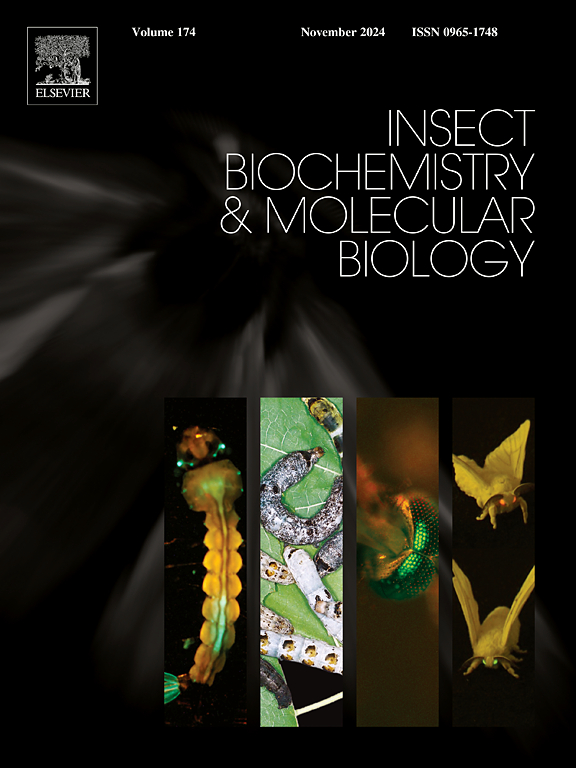花蛾科斑蝥素生物学特性及合成途径的研究进展。
IF 3.7
2区 农林科学
Q2 BIOCHEMISTRY & MOLECULAR BIOLOGY
引用次数: 0
摘要
斑蝥素是一种主要来源于蛾科昆虫的防御性次生代谢物,是一种具有良好临床疗效的活性化合物。斑蝥素合成途径的研究不仅是斑蝥素科中最有趣的研究领域之一,而且在弥合生物防御机制和临床应用之间的差距方面也有希望。本文简要介绍了花蛾科甲虫与斑蝥素有关的生物学特性。综述了斑蝥素合成途径的最新研究进展,重点从倍半萜前体的合成、法尼醇的生成与代谢、及其与幼体激素代谢的关系三个方面进行了综述。假设生物合成途径从甲羟戊酸途径开始,甲羟戊酸途径合成法尼醇,这是斑蝥素的鉴定前体。法尼醇随后被酶转化为法尼醇酸,后者进一步转化为幼激素酸。幼激素酸随后转化为幼激素酸二醇,参与斑蝥素的合成。最后,根据目前的研究成果,提出了斑蝥素的推测合成途径,并讨论了其意义。本文章由计算机程序翻译,如有差异,请以英文原文为准。

Research progress on the biological characteristics and the synthesis pathway of cantharidin in the family meloidae (Insecta: Coleoptera)
Cantharidin, an active compound with well-established clinical efficacy, is a defensive secondary metabolite primarily derived from insects in the Meloidae family. The study of cantharidin's synthetic pathway is not only one of the most intriguing research areas within the Meloidae family, but also holds promise in bridging the gap between biological defense mechanisms and clinical applicability. This paper provides a concise overview of the cantharidin-related biological characteristics of Meloidae beetles. It then summarizes recent advances in research on the synthetic pathway of cantharidin, focusing on three key areas: the synthesis of sesquiterpene precursors, the production and metabolism of farnesol, and its connection to juvenile hormone metabolism. The hypothesis is proposed that the biosynthetic pathway starts with the mevalonate pathway, which synthesizes farnesol, the identified precursor of cantharidin. Farnesol is subsequently converted by enzymes into farnesoic acid, which is further transformed into juvenile hormone acid. Juvenile hormone acid is then converted into juvenile hormone acid diol, which participates in the synthesis of cantharidin. Finally, we propose a speculative synthesis pathway for cantharidin based on current research findings and discuss its implications.
求助全文
通过发布文献求助,成功后即可免费获取论文全文。
去求助
来源期刊
CiteScore
7.40
自引率
5.30%
发文量
105
审稿时长
40 days
期刊介绍:
This international journal publishes original contributions and mini-reviews in the fields of insect biochemistry and insect molecular biology. Main areas of interest are neurochemistry, hormone and pheromone biochemistry, enzymes and metabolism, hormone action and gene regulation, gene characterization and structure, pharmacology, immunology and cell and tissue culture. Papers on the biochemistry and molecular biology of other groups of arthropods are published if of general interest to the readership. Technique papers will be considered for publication if they significantly advance the field of insect biochemistry and molecular biology in the opinion of the Editors and Editorial Board.

 求助内容:
求助内容: 应助结果提醒方式:
应助结果提醒方式:


